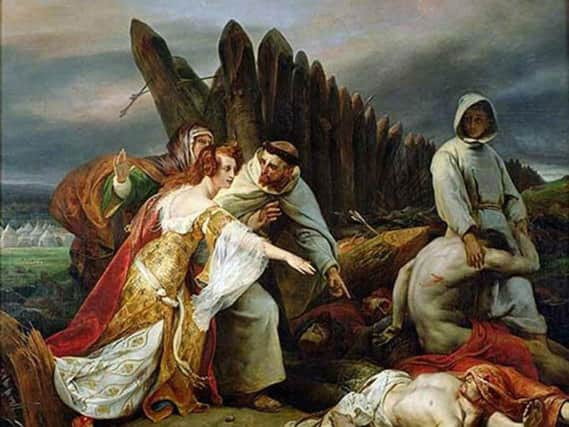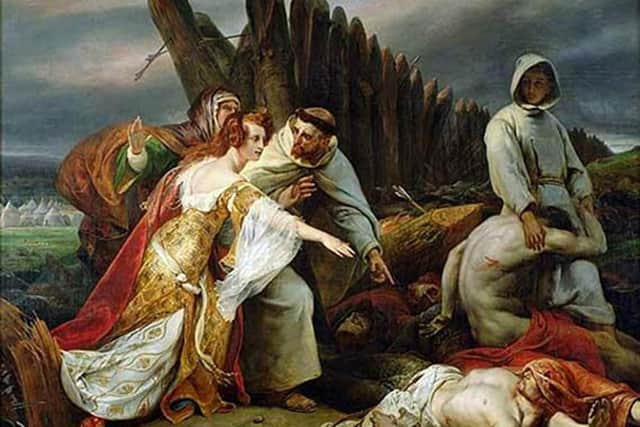Edith Swan-Neck sought the body of King Harold


This month sees the 950th anniversary of the Battle of Hastings marked with a huge re-enactment of the momentous clash of arms on a Sussex hill that changed Britain’s history forever. There will most certainly be plenty of press and TV coverage concerning Duke William of Normandy’s successful invasion so rather than add to the conventional story I thought I would cast about for different angles on what is largely a very familiar tale.
First stop for me was historian Edward Verrall Lucas and his fascinating book “Highways and Byways in Sussex” first published in 1904. In it he writes of the Norman nobleman William de Warenne, a close friend of William the Conqueror and a staunch and fearless fighter at Hastings. Post-battle he was a major beneficiary of honours and huge grants of land given him in gratitude by the new King of England. Not least was the gift of the town of Lewes.
Advertisement
Hide AdAdvertisement
Hide AdLucas writes: “Ten years after the victory at Hastings the memory of the blood of the sturdy Saxons who he had hacked down at Battle began to weigh so heavily upon de Warenne’s conscience that he set out with his wife Gundrada upon an expiatory pilgrimage to Rome. Sheltering on the way in the monastery of St Per at Cluny, they were so hospitably received that on returning to Lewes, the pair had a priory built, partly as a form of thanksgiving, partly as a safeguard for the life to come. In 1078, it was formally founded on a magnificent scale. Thus Lewes obtained her castle and her priory in the one of which William de Warenne might sin with a clear mind, knowing that just below him, on the edge of the water-brooks, was (in the other) so tangible an expiation.”


Lucas then adds: “That date 1078 rather spoils the pleasant legend that tells how King Harold, actually only badly wounded, was carried hither from Battle, and how, recovering, he lived quietly with the brothers in Lewes Priory until his natural death some years later. A variant of the same story takes the English king to a cell near the site of present day St John’s sub Castro Church, also in Lewes, and establishes him there as an anchorite.
“Even so all true Englishmen prefer to think of Harold fighting in the midst of his army, killed by a chance arrow shot into the zenith, and lying there until the eyes of Edith of the Swan-Neck lighted upon his dear corpse amid the hundreds of the slain.”
Edith was the wife or consort of Harold and was also known as ’Edith the Fair”. She is remembered in folklore as the person who identified Harold’s mutilated body following the battle through love bites only she knew she had administered on the night before the fight. She is said to have offered her husband’s weight in gold to be allowed to give his corpse a Christian burial but the triumphant Normans refused her request, fearing that Harold’s burial place would become a rallying point for any future English resistance movements.
Advertisement
Hide AdAdvertisement
Hide AdThe only known surviving contemporary account of the conflict is contained in the “Carmen de Hastingae Proelio”. This translates as “Song of the Battle of Hastings” and is attributed to Bishop Guy of Amiens who is believed to have written it within a year or so of the coronation of William as King of England. It says that after the battle William had his tent set up “in the midst of the dead, and there he ate and drank”. In the morning the Norman fallen were buried with due rites; the Saxon corpses were left to rot.
Six centuries later in 1662 Thomas Fuller in his book “The Worthies of England” has this to say about the Hastings battlefield: “That in this county of Sussex, not far from Battail-Abby, in the place where so great a slaughter of the Englishmen was made, after any shower, presently sweateth forth very fresh blood out of the Earth, as if the evidence thereof did plainly declare the voice of blood there shed, and crieth still from the Earth unto the Lord.'
All of the above takes no note of the famous Bayeaux Tapestry. This amazing example of the weaver’s art is truly a wonder of the medieval age. But it necessarily tells the story of the Conquest in very broad brush terms. It is also thought to have been strongly influenced by Bishop Odo of Bayeaux. Now while he may have the title of a man of the cloth, Odo was also a seasoned soldier who came ashore at Pevensey and went on to fight with William with distinction at the place we now call Battle.
Into the bargain Odo was a ruthless politician and ironically it was at Pevensey some decades after the Norman Conquest that he would land himself in dangerously hot water – a tale I will tell next week.
Advertisement
Hide AdAdvertisement
Hide AdIn the meantime let me draw to your attention that the excellent Pevensey Court House Museum has a special “Great 1066 Invasion” exhibition open from 11am to 4pm this month on the 9th, 14th, 15th and 16th October. Admission is just £2 per adult and accompanied children under 16 go free. Well recommended.